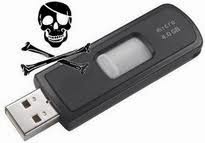HOW TO DISABLE/ENABLE USB PORTS TO PREVENT INFECTION…

how to block USB ports.Many of colleges block the USB port so that students can not use USB port to infected the college systems.I am suffering from this problem also so today i found a idea early in the morning to enable these USB ports.Many of my friends ask me to enable USB port and some to disable.so i am here discuss both methods Disable or enable USB ports …..☻
Method # 1:-
To do so:
Disable autorun feature to protect your system
- First, the key combination Win + R and type Gpedit.msc
- Navigate to Computer Configuration > Administrative Templates > Windows Components, then click Autoplay Policies. (XP users should try Computer Configuration >Administrative Templates > System
- In the Details pane, double-click Turn off Autoplay.
- Click Enabled, select All drives in the Turn off Autoplay box to disable Autorun on all drives.
Method # 2:-
HKEY_LOCAL_MACHINE\SYSTEM\CurrentControlSet\Services\UsbStorand set the value of Start to 4. To enable access again change the value back to 3 Although the site mentions that this applies to Windows XP, 2000 and 2003 it worked just fine on Windows Vista and Windows 7,8,8.1 as well.
Method # 3:-
Method # 4:-
Disable/Enable usb port with driver
- Go to Device Manager (Right click My Computer, choose Manage, choose Device Manager in left pane)
- Now look for USB Devices in the right pane, right click on the device and choose disable.
Now double clicking on this file will enable access, similarly you can change 00000003 to 00000004 to create a reg file for disabling access. None of these are fool proof, there is always someone smart enough to find a way around. If you really want to go all the way you can fill the ports with some epoxy or a similar substance! This is of course not a recommended solution for your personal computer but might come in handy for large organizations trying to prevent employees from using USB devices. All in all the options are good enough to stop accidental, non intentional spread of malware/compromise of your computer as mostly happens when a USB device is plugged into different computers. However don’t bet your life on these if some one is really determined to use a USB device on your computer for whatever reason.Now you can also use data drive in your college systems. Enjoy!! leave comments….☻☻☻☻♥

.png)
.png)
.png)







0 comments:
Post a Comment